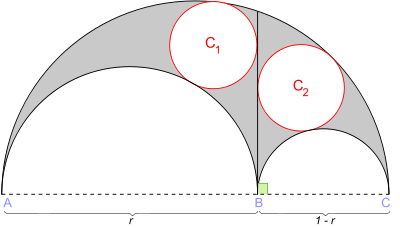Archimedes' twin circles

In geometry, specifically in the study of the arbelos, the Archimedes' circles are two special circles associated with it.
Specifically, let  ,
,  , and
, and  be the three corners of the arbelos, with
be the three corners of the arbelos, with  between
between  and
and  . Let
. Let  be the point where the larger semicircle intercepts the line perpendicular to the
be the point where the larger semicircle intercepts the line perpendicular to the  through the point
through the point  . The segment
. The segment  divides the arbelos in two parts. The Archimedes' circles are the two circles inscribed in these parts, each tangent to one of the two smaller semicircles, to the segment
divides the arbelos in two parts. The Archimedes' circles are the two circles inscribed in these parts, each tangent to one of the two smaller semicircles, to the segment  , and to the largest semicircle.[1]
, and to the largest semicircle.[1]
These circles are named after the Greek mathematician Archimedes, who defined them and showed that they are congruent, whatever the sizes of the semicircles  and
and  . This is proposition 5 of his Book of Lemmas.[2] The circles are also known as the Archimedean circles, Archimedean twins, or other similar names.[3]
. This is proposition 5 of his Book of Lemmas.[2] The circles are also known as the Archimedean circles, Archimedean twins, or other similar names.[3]
Construction
Each of the two circles is uniquely determined by its three tangencies. Constructing it is a special case of the Problem of Apollonius.
Properties
Let a and b be the diameters of two inner semicircles, so that the outer semicircle has diameter a+b. The diameter of each Archimedean circle is then[1]
Alternatively, if the outer semicircle has unit diameter, and the inner circles have diameters  and
and  , the diameter of each Archimedean circle is[1]
, the diameter of each Archimedean circle is[1]
 .
.
The smallest circle that encloses both Archimedean circles has the same area as the arbelos.[1]
Alternative constructions
Since Archimedes, dozens of alternative ways of constructing two circles congruent to the Archimedean twins have been found,[4] and the list is still growing.[3][5]
See also
References
- ↑ 1.0 1.1 1.2 1.3 Weisstein, Eric W. ""Archimedes' Circles." From MathWorld--A Wolfram Web Resource". Retrieved 2008-04-10.
- ↑ Thomas Little Heath (1897), The Works of Archimedes. Cambridge University Press. Proposition 5 in the Book of Lemmas. Quote: "Let AB be the diameter of a semicircle, C any point on AB, and CD perpendicular to it, and let semicircles be described within the first semicircle and having AC, CB as diameters. Then if two circles be drawn touching CD on different sides and each touching two of the semicircles, the circles so drawn will be equal."
- ↑ 3.0 3.1
- ↑ Floor van Lamoen (2014), A catalog of over fifty Archimedean circles. Online document, accessed on 2014-10-08.
- ↑ Floor van Lamoen (2014), Circles (A61a) and (A61b): Dao pair. Online document, in <ref name=lamoenCat/> accessed on 2014-10-08.</ref> <ref name=dao.arbel2014>Đao Thanh Oai (2014), Two pairs of Archimedean circles in the arbelos. Forum Geometricorum, volume 14, pages 201–202, ISSN 1534-1178.
